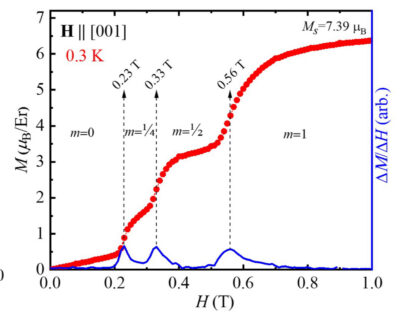New preprint on Fractional Magnetization Plateaus in a New Shastry-Sutherland Ising Compound
New preprint arXiv:2405.12405 entitled „Unprecedented Fractional Magnetization Plateaus in a New Shastry-Sutherland Ising Compound“! Nice experimental-theory collaboration between Duke University, Ecole Polytechnique Federale de Lausanne, FAU Erlangen-Nürnberg, Oak Ridge National Lab, and National High Magnetic Field Laboratory. Main credit to Lalit Yadav, Alfonso Rufino, Frederic Mila, and Sara Haravifard and contributions from LEP members Jan Alexander Koziol and Kai Phillip Schmidt.
Geometrically frustrated magnetic systems, such as those based on the Shastry-Sutherland lattice (SSL), offer a rich playground for exploring unconventional magnetic states. The delicate balance between competing interactions in these systems leads to the emergence of novel phases. We present the characterization of Er2Be2GeO7, an SSL compound with Er3+ ions forming orthogonal dimers separated by non-magnetic layers whose structure is invariant under the P-421m space group. Neutron scattering reveals an antiferromagnetic dimer structure at zero field, typical of Ising spins on that lattice and consistent with the anisotropic magnetization observed. However, magnetization measurements exhibit fractional plateaus at 1/4 and 1/2 of saturation, in contrast to the expected 1/3 plateau of the SSL Ising model. By comparing the energy of candidate states with ground-state lower bounds we show that this behavior requires spatially anisotropic interactions, leading to an anisotropic Shastry-Sutherland Ising Model (ASSLIM) symmetric under the Cmm2 space group. This anisotropy is consistent with the small orthorhombic distortion observed with single-crystal neutron diffraction. The other properties, including thermodynamics, which have been investigated theoretically using tensor networks, point to small residual interactions, potentially due to further couplings and quantum fluctuations. This study highlights Er2Ge2GeO7 as a promising platform for investigating exotic magnetic phenomena.

